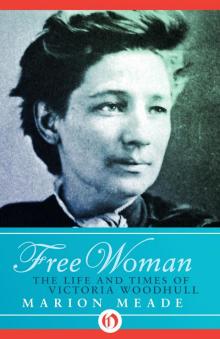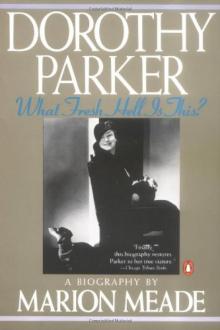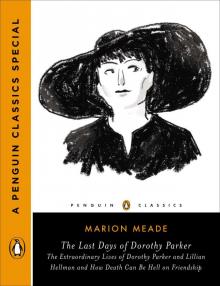- Home
- Marion Meade
Unruly Life of Woody Allen
Unruly Life of Woody Allen Read online
The Unruly Life of Woody Allen
A Biography
Marion Meade
For Katharine Rose Sprague
AUTHOR’S NOTE
Sources for Woody Allen's quotations are cited in the Notes.
PROLOGUE
Grapes of Wrath
January 13, 1992
It was crazy weather for January. A sudden balmy spell swept a froth of showers and the fresh breezes of April into the city in the dead of winter. On Fifth Avenue, tangled morning traffic inched south toward the crosstown intersection at Seventy-second Street. Under a mottled gray sky, packs of MTA buses, white-and-blue, bunched in twos and threes, crept like a rare breed of tiger down the puddled asphalt of the Upper East Side, swerving royally past fortresses guarded by chandeliered lobbies and spiked gates (where you could buy a full-floor cooperative of eighteen rooms for $14 million); double-parked limousines studded with diplomatic license plates; and imperial-guard doormen all armed with glistening black umbrellas and silver whistles. On the side of every building was clearly posted the constitutional law of the land: ALL DELIVERIES MUST GO THROUGH SERVICE ENTRANCE.
Number 930 Fifth Avenue is a creamy-colored chunk of limestone and brick, its shiny steel-trimmed Art Deco canopy not facing Central Park but located around the corner on narrow East Seventy-fourth Street. The building's shareholders live in big apartments with servants' quarters behind the kitchen and wood-burning fireplaces. More often than not, they own country houses. While 930 does not happen to be among the Avenue's elite Social Register addresses—those dozen or so buildings considered white-glove—it is definitely blue-chip, and folks feel particular about their neighbors. They are partial to prospective buyers who maintain a modest profile, which is why entertainers with squealing fans never manage to make it past the co-op board.
Their most famous tenant is a man living in the duplex penthouse, whose double terraces afford a sweeping view of the park—the Bethesda Fountain, the lake, and Strawberry Fields to the west. (The penthouse had been written up in Architectural Digest.) He had purchased the eight-room apartment twenty-two years earlier, just as he was achieving fame and fortune in films, after being hailed by one and all as a brilliant young stand-up comedian, the comic's comic, and he had lived there in comfort for most of his adult life. In December he turned fifty-six. He still weighed 128 pounds, but his boyish physique had begun to show signs of wear, and he looked like a smaller, frailer version of himself. Even though he scorned face-lifts, as well as nip-and-tucks, his raggedy reddish hair was stabilized with transplants and dye and combed forward to make himself look youthful. He continued to sport the uniform of a sixties college student: cotton sport shirts, cashmere sweaters, khakis, and tweed jackets. To those who crossed his path in the lobby, he seemed uncommonly reserved. Some of his neighbors judged him a sweetheart who could always be counted on for generous donations to the block association. But to others he was a bit of a sourpuss.
The trouble was that he did not, on the whole, enjoy people very much. There were plenty of things he did appreciate—the New York Knicks, Groucho's gags, Mahler's Fourth Symphony—but he had never felt at ease around people (with some exceptions) or pets and animals (no exceptions). Riding the elevator up to his penthouse, he was known to face the wall like Greta Garbo or stick his nose in a paper to avoid conversation.
On this second Monday of January, after sleeping his usual seven hours, he woke up in his king-size, four-poster, canopy bed with a blue-calico spread. Outside his window, the skies were overcast and it was sprinkling. When the weather was gray and drizzly, he felt reassured that life would go on forever. Sunny days made him want to hide under the covers and think of dying.
A creature of habit, he seldom varied his early-morning routine of treadmill and shower, followed by having his regular breakfast of prune juice and Cheerios with raisins and sliced bananas as he read the New York Times. An article reported that he had attended a cocktail party on Friday night, after a private screening of a picture produced by his best friend, and that he sipped a lovely Pavilion Blanc du Chateau Margaux 1986. After finishing the Times, he practiced his clarinet for an hour and then departed for his editing office. Ordinarily, he breezed around the city in his black Mercedes sedan, or a rattling old station wagon, with his driver Don Harris behind the wheel. However, he preferred walking the thirteen blocks to his office at 575 Park Avenue, usually following the same route. At the intersection of Seventy-fourth Street and Madison Avenue, he headed south past Clyde Chemists, which delivers prescriptions to the luxury buildings on Fifth Avenue; past Ralph Laurens flagship store where he had shot scenes for Alice, notably the one in which an invisible Joe Mantegna sneaks into a changing booth with supermodel Elle Macpherson; past the plush Polo restaurant in the Westbury Hotel—a block of cherry-red awnings, where you could spend sixteen dollars on a half portion of fettuccine with fresh crepes, Swiss chard, and mushroom cream; and finally into the valley of the couture ghetto—the houses of Gianni Versace, Giorgio Armani, Valentino—before turning east to Park Avenue.
This morning, he was working on a new picture with his editor, Sandy Morse, who had been with him for fourteen movies. At present, the movie's working title was "Woody Allen Fall Project '91," but eventually it would be called Husbands and Wives. Over the years constant experimentation had enabled him to devise an efficient method of working. He shot scenes in one or two setups; dispensed with close-ups and worked only in master shots; eliminated actors' rehearsals and allowed them to change dialogue; and seldom offered direction—all shortcuts allowing him to finish a picture before he got sick to death of it. This time, the use of handheld-camera techniques and long takes running up to nine minutes permitted an even hastier shoot than usual. It was crude, off-the-cuff filmmaking that, in the hands of a less-confident artist, could have spelled amateur, but for him it meant principal photography could be completed ahead of schedule. With every picture, he started out with a strong idea. Unfortunately, however hard he tried, the original idea, gradually diluted along the way, never made it to the screen exactly as planned. Personally, he often said, he didn't care one way or the other what people thought of his films, just as he never saw his pictures after release and never read reviews. More and more, as he grew older, he thought of his work as self-therapy, a means, he said, of keeping busy "so I don't get depressed." But even before the reshoots, he felt good about "Woody Allen Fall Project '91," which was coming in under budget. Already in the pipeline was his next project—his twenty-third film—a murder mystery in which he would play an amateur detective. Shooting would begin in September.
Midway through the day, an assistant ordered takeout for him. It was his regular lunch, the same type of sandwich that he had eaten for the last forty-five years—tuna salad (or occasionally turkey for a change), no lettuce, no tomato, on healthful white bread, followed by a Nestle Crunch bar or chocolate cake and coffee. On a typical winter evening, after leaving his office, he could be found at Madison Square Garden, watching the New York Knicks from his courtside seats behind the scorer's table. On Monday nights, he would head to his weekly concert at Michael's Pub on East Fifty-fifth Street, where he had been playing New Orleans jazz for more than two decades. Afterward, he would go home, get a bite to eat, usually chocolate-chip cookies washed down with two glasses of milk, and go to bed.
All things considered, there was much for Woody Allen to feel pleased about. In recent months, he had earned $2 million for a series of TV commercials promoting Italy's biggest supermarket chain. And in the bookstores, an adoring new biography solidified the popular myths about himself and his beloved leading lady, the golden-haired waif with the Dresden complexion and chiseled cheekbones.
> Midafternoon, Mia Farrow and her four-year-old son, Satchel, who is also Woody's son, stepped off the elevator into the foyer of Woody's penthouse. The actress reached under the umbrella stand for the key.
In backgrounds, Maria de Lourdes Villiers Farrow and Allan Stewart Konigsberg could not have been more dissimilar—a Hollywood blue blood and a Flatbush frog turned movie prince—but they had been together for a dozen years, working side by side in thirteen films. As the quintessential Hollywood couple of the eighties, the new Tracy and Hepburn, Woody and Mia were truly an unusual pair—even for movie stars. They were not married. They did not even live together.
Mia had nine children, three biological with her former husband, the prominent conductor Andre Previn, five adopted, and one, Satchel, whom Woody and Mia had together. Because the commotion made by so many youngsters jangled Woody's nerves, Mia had remained on the opposite side of the park in her eight-room home at 135 Central Park West, the apartment in the Langham where Woody had filmed the Thanksgiving scenes in Hannah and Her Sisters. On a clear day, according to local Mia-Woody folklore, the lovers could gaze at each other across the expanse of Central Park through binoculars and wave towels. Several weeks earlier, Woody had co-adopted two of Mia's five adopted children—Korean-born Moses, thirteen, and six-year-old Dylan. While he doted on Dylan, Woody never managed to form a strong bond with his own little boy. Whether for this reason or not, Satchel O'Sullivan Farrow had begun experiencing emotional difficulties. When playing dress-up, for example, he didn't care to act the Prince, and instead always pleaded for the part of Cinderella. His father considered his son wanting to play Cinderella a problem, and so Satchel began therapy with a clinical psychologist in June of 1990, at which time he was only two years and seven months old. Instead of consulting Dr. Susan Coates at her office, Satch had his sessions at his father's apartment. It would not do for word to leak out that Woody's little boy, hardly more than a baby, who was until recently breastfeeding, was so screwed up that he required a shrink.
For the hour Satch was closeted with the gender specialist, his mother waited in the den. In the room where she settled into a chair, there were floor-to-ceiling bookshelves and a comfortable desk, although Woody did his writing with pencil and legal pad upstairs on his bed. The coffee table was always cluttered: He subscribed to National Geographic, The New York Review of Books, The New Republic, and there were piles of books, as well as bowls of nuts and fancy candies. To pass the time, Mia thumbed through The Crooked Timber of Humanity by Isaiah Berlin, the philosopher who is Woody's favored essayist. When the telephone rang, she answered knowing that it would be Woody. The previous evening, as on other Sunday nights, they had spent together in her kitchen eating a meal of take-out Chinese with the kids, but there was always news to exchange, and so they spoke on the telephone four or five times a day. After hanging up, she stepped over to the fireplace, where she reached for a box of tissues on the mantel. Under the box, a stack of Polaroid photos caught her eye. They showed a naked woman draped across a sofa, posing suggestively with her legs spread apart, and Mia stared at the pictures in shock and horror. As she wrote in her autobiography, What Falls Away, "It took me a moment to realize that it was Soon-Yi," her nineteen-year-old daughter, who to her knowledge lacked any sexual experience, who had never had a date, not so much as a phone call from a boy.
Within minutes she was dialing Woody's office. "I found the pictures!" she screamed. "Get away from us!" Then she phoned her daughter, who hung up on her. "Totally traumatized," she felt as if a stake had been hammered through her heart.
Shortly thereafter, she was seen tearing through the lobby with her son in tow. Her flushed face and rumpled clothing did not seem extraordinary to Woody's neighbors at 930 Fifth. Accustomed to the sight of her yanking around a crew of kids, her tousled hair looking like a hayloft, one occupant recalled, "She always looked like she had just left a mental hospital or was on her way to one."
In the dusky air, the lamps along the footpaths were flickering on automatically as Mia bundled Satchel into a cab and crossed the park with the photographs tucked in her bag. In the hallway of her apartment, she met one of her twin sons. "Woody's been fucking Soon-Yi," she announced to twenty-one-year-old Sascha. "Call Andre." Then she raced into Soon-Yi's room with the pictures. Her voice rose to a screech. "What have you done?"
"Twenty minutes after she found the Polaroids," remembered one of Mia's intimates, "everyone in the family knew about it."
Soon afterward, the glass-and-wrought-iron door of the Farrow apartment burst open. Using his personal key, Woody let himself in and headed down the hall toward Mia's bedroom. Behind the closed door, he admitted to an affair that he said had started a few weeks earlier at Christmas. The Polaroids were shot only the previous night, after dinner, upon their return to his apartment. While sitting around talking, Soon-Yi spoke of wanting a modeling career and suggested he take pictures of her. He found a camera, she undressed, they embarked on an impromptu photo shoot. He recalled having posed her on the sofa, telling her to "lay back and give me your most erotic poses. Let yourself go."
These explanations, however, sounded preposterous to Mia. The photographs did not appear to be posed because Soon-Yi was laughing. They had an eerily spontaneous quality. Horrified that he had dared to seduce her daughter, Mia also felt disgusted about the pictures, which looked pornographic and were left in plain view on the mantel for anyone to see. Astonished by her references to pornography, Woody replied that no sexual acts were shown and would later describe the snapshots as nothing but "graphic, erotic pictures taken between two consenting adults."
That night, he failed to show up at Michael's Pub for his weekly performance. For several hours, he remained in Mias room. Although he was not quite sure what to tell her, he continued to assure her of his love, she would later recall. The escapade with her daughter, he said, was an insignificant flirtation, "a tepid little affair" that had run its course anyway. He told her that they would get through this bad time and hopefully build a stronger relationship. It might even turn out to be a positive experience for Soon-Yi in the long run. Certainly the girl had not been exploited. She was, after all, an adult who had not been forced to do anything against her will. As he reminded Mia, he was not Soon-Yi's father or stepfather, not even a father figure. Throughout his explanations, Mia barely listened. She was unable to stop crying. Afterward, reporting to a friend, she described her humiliation as "a meltdown of my very core." Woody, too, would remember that she sounded incoherent, "beside herself in rage and anger." Unprepared to play this sort of richly emotional scene, he fled from the apartment when it became more than he could bear.
An hour later, as Mia and the children were having supper, he reappeared. In the kitchen, he stood silently behind the table at first and watched them eating. Nobody spoke to him. Stone-faced, they stared into their plates. In desperation, he sat down at the table and started "chatting with the two little ones, said hi to everybody" as if nothing had happened, Mia would remember. But one by one the older children picked up their plates and left the room.
Almost anywhere in the world, Woody Allen was a household name. With a face as familiar as that of Elvis or Marilyn, he was famous enough to be known by his first name. Everyone recognized the sober demeanor, the trademark black-rimmed glasses, the floppy tan hat that he adopted as a public disguise but which seldom fooled anyone. After thirty years in the spotlight—as comic actor, movie star, author, serious director, amateur musician, maverick filmmaker, and professional neurotic—he was a living legend considered by many to be America's most brilliant humorist, an artist of indisputable originality, a master of irony, the darling of the intelligentsia. Incredibly, he had turned out no fewer than twenty-one features, some classics of the screen and a number of clinkers, but still a formidable record matched by few contemporary filmmakers.
Numbers, however, did not begin to convey his universal appeal. Between 1968 and 1977, he had done nothing less than make the who
le world love him and his movies. How could anyone forget Take the Money and Run and the most hilarious bank holdup ever filmed, the obvious absurdity of an incompetent crook with crummy penmanship hoping to succeed with a handwritten note? He had us roaring in Everything You Always Wanted to Know About Sex (But Were Afraid to Ask), when his frantic medieval court jester tries to pick the lock of the queen's chastity belt. "I must think of something quickly," he murmurs to himself, "because before you know it the Renaissance will be here, and we'll all be painting." And who else but Woody could create the sheer fun of Bananas, when his character feeds the rebel troops by ordering takeout from a local greasy spoon: "A thousand grilled cheese sandwiches, three hundred tuna fish, two hundred b.l.t.'s (one on a roll), and coleslaw for a thousand, mayo on the side."
Beyond the laughter, Woody set himself apart by playing the game on his own terms. A nonconformist off the screen, he wore his independence as a kind of badge and lived as he pleased. He hated to compromise but when he did, it was dramatic. In his younger days, he once escorted First Lady Betty Ford to a black-tie gala benefit for Martha Graham's dance company. At the Uris Theater, he made his entrance with the president's wife, and, in the manner of a movie star caught in flagrante delicto, announced to reporters that "we're just good friends." Mrs. Ford wore a purple chiffon dress; he was clad in a tuxedo and black tie, and his feet were encased in white sneakers, an outfit that demanded immediate attention.
Likewise, he bravely thumbed his nose at the Hollywood establishment and created his idiosyncratic pictures on the fringes of the system. From sketch comedies, he progressed to subtle, sophisticated romances such as Annie Hall, and crashed the ranks of Chaplin, Keaton, Welles, and Bergman (whom he unashamedly confessed was his idol) as an auteur, who wrote, directed, produced, acted in, and otherwise controlled every aspect of his own work. Even though he had spent only four or five days in the movie capital in the last twenty years, his place in the Hollywood pantheon of superstars could not have been more solid. Hardly an actor alive, offered a chance to work in a Woody Allen film, would not happily accept the sort of walk-on roles normally reserved for unknowns and cut his price to work for union scale. Some accepted roles without asking to see the script.

 Eleanor of Aquitaine
Eleanor of Aquitaine Free Woman
Free Woman Unruly Life of Woody Allen
Unruly Life of Woody Allen Bobbed Hair and Bathtub Gin
Bobbed Hair and Bathtub Gin Madame Blavatsky
Madame Blavatsky Stealing Heaven
Stealing Heaven Dorothy Parker: What Fresh Hell Is This?
Dorothy Parker: What Fresh Hell Is This? The Last Days of Dorothy Parker
The Last Days of Dorothy Parker